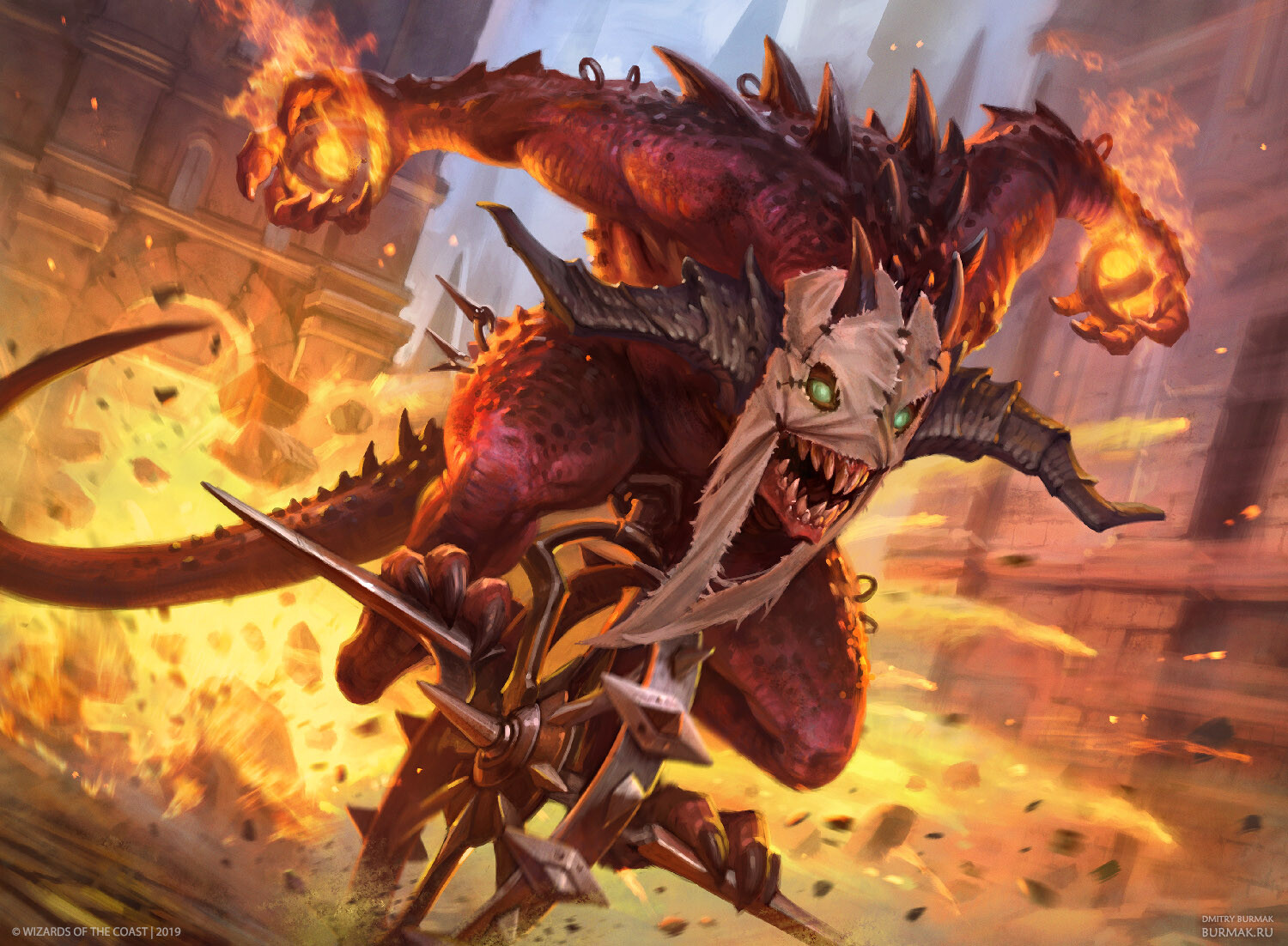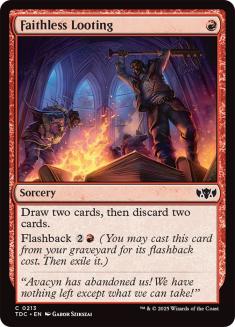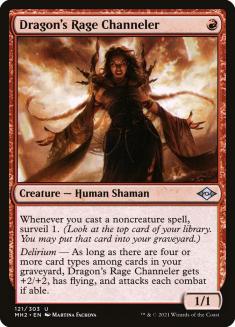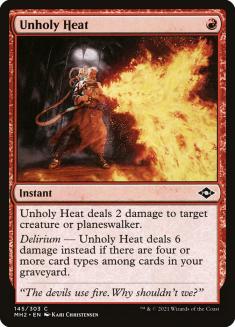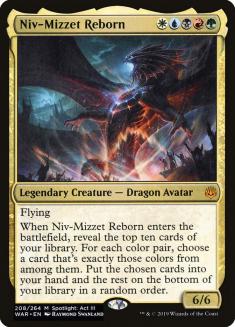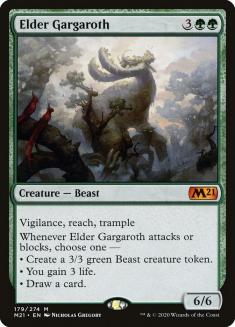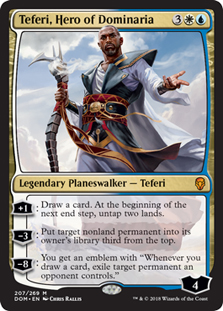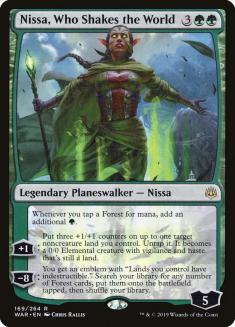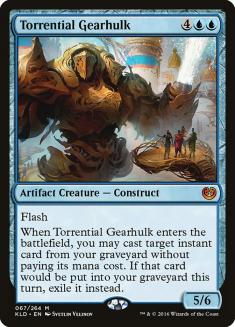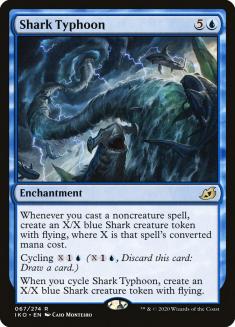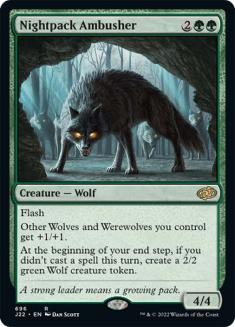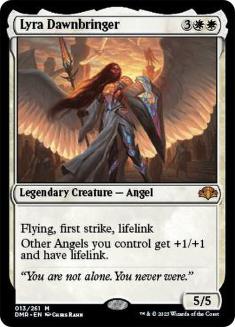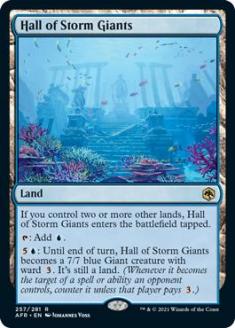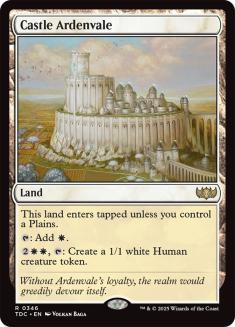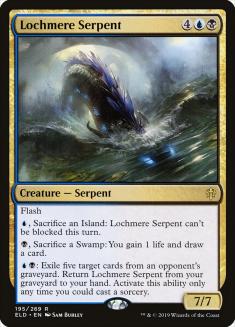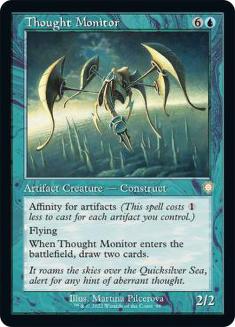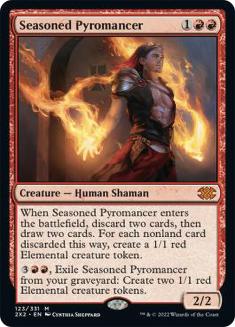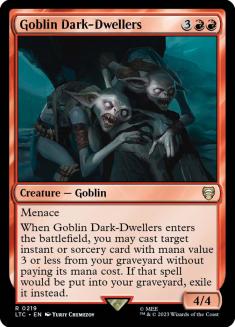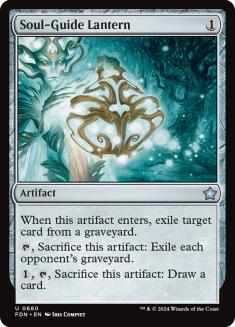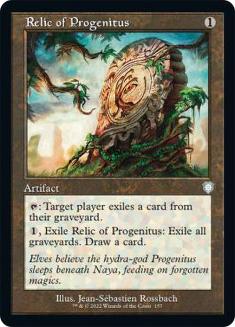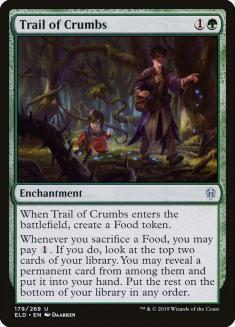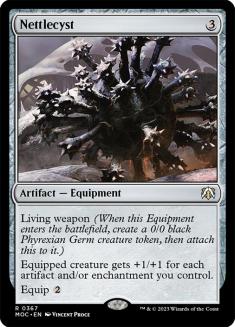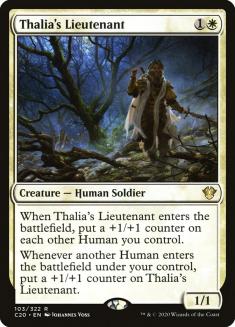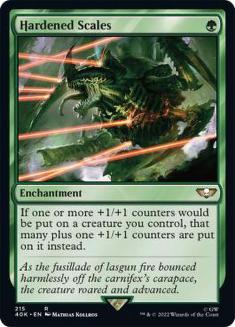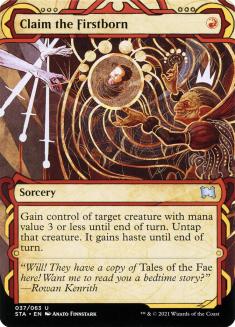We should have been conducting madcap experiments with the new Jumpstart: Historic Horizons cards already. Instead, its release was delayed just long enough for its thunder to be stolen by the announcement of next year’s roster. The Rivals Gauntlet, which could and should have showcased a wild new Historic format, will only feature an obsolete Standard format that players were so sick of that Standard 2022 had to be created to keep Arena users interested. I don’t know if Historic deserved better but its fans certainly did.
Whatever the timing issues, players who head into the Historic queues this week will find a format going through yet another serious upheaval. Last time, I dipped my toe into some of the more speculative decks that may rise or return with Jumpstart, but it’s worth checking in on some of the format’s previous top players.
Winner: Faithless Looting
Brainstorm and Faithless Looting were two of the most startling additions to Historic from the Mystical Archive and worked in tandem to power a succession of the format’s best decks. Looting now stands unrivalled as the best card filtering spell in Historic and is the perfect partner in crime for the best cards in Jumpstart: Historic Horizons.
Creatures (14)
Lands (13)
Spells (33)

Izzet Phoenix was the most popular and successful deck in Historic after Jeskai Indomitable Creativity was cut down by the loss of Time Warp. Brainstorm’s entirely predictable ban hit all of the remaining Steam Vents decks vying for dominance but its impact was uneven, as Jeskai Control rose up to take over most of Izzet Phoenix’s metagame share for the Challenger Gauntlet. This wasn’t because Izzet Phoenix was a particularly good Brainstorm deck — it will be much happier to cast Consider when Innistrad: Midnight Hunt rolls around — but it was hard for Phoenix to fill out its starting 60 with cards it actually wanted to play beyond the core that makes it so appealing.
It’s safe to say that problem is solved.
After reshaping midrange decks in Modern, Dragon’s Rage Channeler and Unholy Heat are taking their talents to a new format and each fixes a glaring and long-standing weakness of Izzet Phoenix. The non-Phoenix threats all place their own deckbuilding and sequencing demands on you and these are often in tension with each other. They also all cost two or more mana, making it hard for a threat-light hand to remedy that by chaining cantrips to find and deploy a threat on the same turn and hard for a threat-heavy hand to unload them all in a reasonable time frame.
Dragon’s Rage Channeler is the ideal one-drop to set up later threats (including a spell chain culminating in at least one Arclight Phoenix) or dig for with cantrips when you need to apply pressure; in particular, Expressive Iteration gets a lot stronger when you have strong one-drops to exile and cast immediately. Turn 1 Channeler followed by Turn 2 Sprite Dragon is remarkably likely to lead to a Turn 4 kill, giving the deck a nut draw that can race the linear decks that may pop up and pop off with this set. Adding the surveil rider to every noncreature spell lets the deck mitigate the risk of flooding that comes with devoting so many spell slots to cards that replace themselves (thereby inflating the relative quantity of lands in your deck).
Unholy Heat finally gives the deck coverage against the creatures that dodge the anaemic damage-based removal in Historic. Lightning Axe did this job even better at times as a discard outlet for Arclight Phoenix but discarding anything else was a steep cost and there were severe diminishing returns on additional Axes. Unholy Heat is an even more versatile removal spell that you’re rarely sad to draw or cast.
Creatures (14)
Lands (18)
Spells (28)

Rakdos Arcanist (Lurrus) has been a consistent player in Historic despite an ongoing identity crisis. Sometimes it looks like a solid but unremarkable midrange deck; sometimes it uses a unique blend of spell payoffs like Young Pyromancer or Dreadhorde Arcanist and sacrifice synergies with Claim the Firstborn and Village Rites/Spark Harvest to set up some truly memorable turns. This can lead to disjointed draws where you successfully trade resources but are left with mopey Stitcher’s Suppliers and conditional interaction, giving the opponent time to recover.
Now, Rakdos Arcanist gets to be the sleek midrange deck it always wanted to be. Dragon’s Rage Channeler adds another impressive threat that still pads the graveyard for those interactions while Unholy Heat gives you a versatile removal spell to recur with Dreadhorde Arcanist.
Loser: Creatures and planeswalkers?
This may sound flippant but it’s not far from the truth. I expect Unholy Heat to become a gatekeeper in Historic as it is in Modern, raising the bar for any expensive threat to justify its existence in the format. Heat is likely to homogenize both the decks that play it and the decks that have to play against it — it’s close enough to Vindicate enough of the time that the natural response of finding threats that dodge it doesn’t work. What are you playing that even has seven toughness or loyalty to begin with? I want The First Sliver to be good as much as anyone but let’s be honest…
This isn’t an automatic death-knell for your favourite five-drop but you can’t count on it surviving reliably. Niv-Mizzet Reborn won’t stabilize the battlefield as often but, if you have enough early interaction that you don’t need it to, Niv-Mizzet’s trigger should still put you far ahead. For a card like Elder Gargaroth that has to enter combat to accomplish anything, the outlook is more bleak.
Loser: Control
The established control decks are most harmed by this dynamic as they rely on planeswalkers that can’t stand the heat. Teferi, Hero of Dominaria is one of the best control finishers of all time precisely because it’s not just a finisher; it’s a source of card advantage, flexible answer, and finisher all at once. This allows you to skimp on other cards that would fill each of those roles as Teferi can cover all of those bases. And when that isn’t true, you can easily find yourself without the right mix of tools to function as a control deck. Teferi’s high starting loyalty used to make it hard to kill and the immediate mana rebate lets you hold up Lightning Helix or other removal for attackers and Dovin’s Veto or Memory Lapse for sorcery-speed answers. None of that matters against Unholy Heat.
Nissa, Who Shakes the World was the backbone of Sultai Ramp and Bant Ramp in simpler times — a serious threat in its own right that turbo-charged Shark Typhoon and Hydroid Krasis. Six loyalty, a 3/3 blocker, and the threat of interaction off that untapped land made removing Nissa in that turn cycle an imposing task and untapping with Nissa was usually game over. Now, Nissa goes up in flames with little to show for your five-mana investment.
The same goes for other common win conditions. Torrential Gearhulk is scary not just as another copy of your control opponent’s best answer but as the biggest thing on the battlefield that suddenly puts you on a fast clock. Shark Typhoon allows control decks to cheat on their finisher count with a card that can be cashed in early, as a mid-sized Shark token later usually gets the job done. Unholy Heat replacing ‘small’ removal like Fatal Push that’s totally dead against Gearhulk or sorcery-speed removal that lets them untap and defend their Gearhulk or Shark is a big upgrade in those matchups. Both of these leave you up a card against Unholy Heat but a control deck should already be ahead on that axis; using your mana in a woefully inefficient way is an easy way to lose as control and trading your turn for a one-drop is a great example of that.
Versatile removal is a good hedge against the unknown too. Sideboard threats like Nightpack Ambusher exploit opponents cutting their nominally dead removal and the threat of these creatures punishes them for drawing too much of it without normal targets. Unholy Heat isn’t earmarked for these cards but its utility against them makes these surprises less effective.
Luckily for control enthusiasts, Historic contains a wide range of win conditions that can be recurred to grind through most interaction or dodge it altogether without taking up valuable spell slots in your deck. The fragility of these mid-game win conditions may encourage a move towards hard control decks that barely contest the battlefield.
More generally, this set is full of cards that are strong and flexible but suggest a certain direction for your deck — even a widely playable tool like Seasoned Pyromancer asks for some work to unlock its full potential. There are few cards that slot neatly into any deck of a given style and this is more important for control decks given their underlying philosophy; the closest thing is Archmage’s Charm, which has strict mana requirements. The card pool was deep enough for Jeskai Control to be the most popular deck at the Challenger Gauntlet pre-Jumpstart but this rising tide isn’t lifting all boats.
I expect the Historic metagame on the ladder to be incredibly diverse at first as players try out the new cards. The idea that control suffers when there isn’t a clear metagame to target is maybe invoked too often, as control’s proactive and reactive cards are both so powerful now that you can brute force your way into wins even when your cards don’t line up perfectly. But this notion gestures at something important — known enemies like Izzet Phoenix and Rakdos Arcanist (Lurrus) have become stronger and the range of unknown enemies is much wider. Preparing for all that at once without losing ground in the control mirror is a challenge that may vex Shaheen Soorani and friends for quite some time.
Winner: Graveyard hate
With the delirium duo poised to shake up Historic, graveyard hate is the best it’s ever been. It’s no coincidence that many Jeskai Control lists already featured maindeck Relic of Progenitus or Rest in Peace to take aim at the Faithless Looting decks and that choice has aged well. Soul-Guide Lantern stands out as a non-symmetrical hate card that these graveyard-centric decks can play themselves while boasting a relatively uncommon card type to help you chase delirium and giving Lurrus of the Dream-Den a cheap card to recur that replaces itself.
Graveyard hate has been overrated against Arclight Phoenix in every format it has appeared in but these additional graveyard synergies (which in turn encourage you to lean in even harder there with cards like Finale of Promise) are important enough that I’d actively want a high quantity of graveyard hate to shore up my Izzet Phoenix matchup.
This hate can also shield your bulkier threats from Unholy Heat, giving those cards room to breathe in these matchups. If the base case of Unholy Heat as Magma Spray is useful against you that hate can’t rescue you there, but there’s a world of difference between killing Teferi, Hero of Dominaria outright and just chipping away at its loyalty.
Loser: Trail of Crumbs
Jund Sacrifice has been a frequent best deck contender throughout Historic’s turbulent life and its positioning is a good bellwether for how sane and stable the format is. When Tainted Pact and Time Warp took over Historic, the idea of playing Jund Sacrifice was laughable. When the format settled down for the brief period after the Brainstorm ban, our own Autumn Burchett and rising star Arya Karamchandani met in the finals of the VML Historic One-Shot tournament with a Jund Food list that took aim at Izzet Phoenix while retaining its strategic edge over Jeskai Control.
Jumpstart: Historic Horizons has a more flat power level than the Mystical Archive but its broad boost in power level mostly misses Jund Sacrifice, which is only in the market for narrow tools and is constrained by the Food package being insular and consuming a lot of space.
Winner: …Mayhem Devil?
That said, I think some kind of Sacrifice deck will still be a top contender once the dust settles. Most of the new strategies that now exist thanks to Jumpstart cards are synergy-driven creature decks that are natural prey for Priest of Forgotten Gods and Mayhem Devil. Yawgmoth, Thran Physician is the most eye-catching pickup for decks in this space and is worth building around but a more classic Jund Sacrifice shell with Collected Company or even Rakdos Sacrifice may be worth revisiting:
Creatures (30)
- 1 Scrapheap Scrounger
- 1 Midnight Reaper
- 4 Priest of Forgotten Gods
- 4 Mayhem Devil
- 4 Yawgmoth, Thran Physician
- 4 Cauldron Familiar
- 4 Woe Strider
- 4 Ravenous Squirrel
- 4 Shambling Ghast
Lands (21)
Spells (9)

Claim the Firstborn may be the real winner here. If you think some kind of Sacrifice deck is well-positioned, it’s because there are creatures to be Claimed everywhere. And if everyone else thinks that too, Claim is one of the most valuable tools in any Mayhem Devil mirror. Any Dragon’s Rage Channeler deck has an appealing target and is likely to support Channeler with cheap threats like Sprite Dragon or Dreadhorde Arcanist that allow Claim the Firstborn to cause some dramatic swings.
Jumpstart: Historic Horizons is a game-changer that will bring new decks to life and force the format’s old guard to question everything. If you want to get an early edge — perhaps for the Arena Open in just a few weeks — knowing how those decks need to adapt is crucial.

